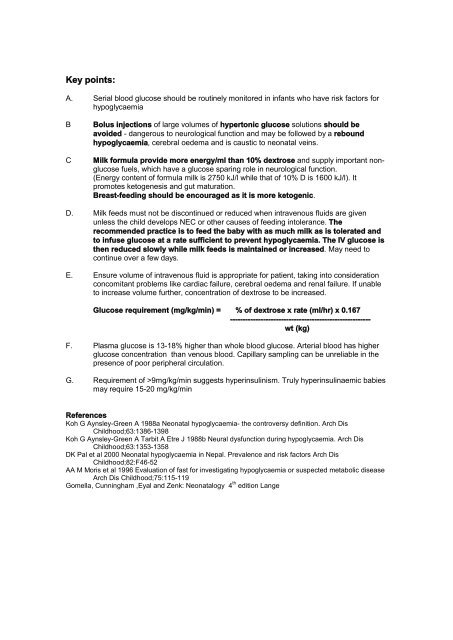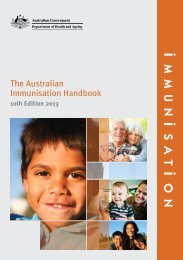Contents Chapter Topic Page Neonatology Respiratory Cardiology
Contents Chapter Topic Page Neonatology Respiratory Cardiology
Contents Chapter Topic Page Neonatology Respiratory Cardiology
Create successful ePaper yourself
Turn your PDF publications into a flip-book with our unique Google optimized e-Paper software.
Key points:<br />
A. Serial blood glucose should be routinely monitored in infants who have risk factors for<br />
hypoglycaemia<br />
B Bolus injections of large volumes of hypertonic glucose solutions should be<br />
avoided - dangerous to neurological function and may be followed by a rebound<br />
hypoglycaemia, cerebral oedema and is caustic to neonatal veins.<br />
C Milk formula provide more energy/ml than 10% dextrose and supply important nonglucose<br />
fuels, which have a glucose sparing role in neurological function.<br />
(Energy content of formula milk is 2750 kJ/l while that of 10% D is 1600 kJ/l). It<br />
promotes ketogenesis and gut maturation.<br />
Breast-feeding should be encouraged as it is more ketogenic.<br />
D. Milk feeds must not be discontinued or reduced when intravenous fluids are given<br />
unless the child develops NEC or other causes of feeding intolerance. The<br />
recommended practice is to feed the baby with as much milk as is tolerated and<br />
to infuse glucose at a rate sufficient to prevent hypoglycaemia. The IV glucose is<br />
then reduced slowly while milk feeds is maintained or increased. May need to<br />
continue over a few days.<br />
E. Ensure volume of intravenous fluid is appropriate for patient, taking into consideration<br />
concomitant problems like cardiac failure, cerebral oedema and renal failure. If unable<br />
to increase volume further, concentration of dextrose to be increased.<br />
Glucose requirement (mg/kg/min) = % of dextrose x rate (ml/hr) x 0.167<br />
------------------------------------------------------wt<br />
(kg)<br />
F. Plasma glucose is 13-18% higher than whole blood glucose. Arterial blood has higher<br />
glucose concentration than venous blood. Capillary sampling can be unreliable in the<br />
presence of poor peripheral circulation.<br />
G. Requirement of >9mg/kg/min suggests hyperinsulinism. Truly hyperinsulinaemic babies<br />
may require 15-20 mg/kg/min<br />
References<br />
Koh G Aynsley-Green A 1988a Neonatal hypoglycaemia- the controversy definition. Arch Dis<br />
Childhood;63:1386-1398<br />
Koh G Aynsley-Green A Tarbit A Etre J 1988b Neural dysfunction during hypoglycaemia. Arch Dis<br />
Childhood;63:1353-1358<br />
DK Pal et al 2000 Neonatal hypoglycaemia in Nepal. Prevalence and risk factors Arch Dis<br />
Childhood;82:F46-52<br />
AA M Moris et al 1996 Evaluation of fast for investigating hypoglycaemia or suspected metabolic disease<br />
Arch Dis Childhood;75:115-119<br />
Gomella, Cunningham ,Eyal and Zenk: Neonatalogy 4 th edition Lange
















